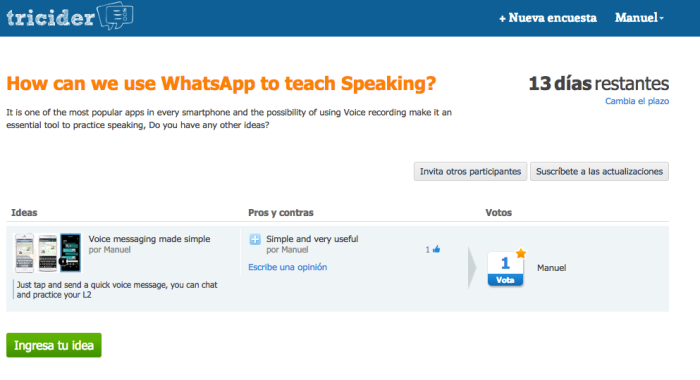Tricider is a great tool to engage your students in the decision-making of the class, this online survey system allows you to write an idea and then let your students collaborate adding new ones, giving instant feedback, adding pros and cons and finally make them part of the class. For example I can make a simple question like: “How can we use WhatsApp to teach Speaking?”
As you can see new ideas can appear, students can provide pros and cons and vote for the best ones. You can invite your students to participate in this survey using Twitter, Facebook, Email or just adding the URL of the survey, like the one in the example: http://www.tricider.com/brainstorming/35eX1nhsdK7
Advantages for this kind of application are tons, but for me the most important is that you can empower your students making them part of the process of their own learner which can motivate them to want to learn more and also provides you with the feedback necessary to pay attention to the needs of your class. Although on the bad side of the story this is only a web application and can only work using a computer and an internet connection, there is no smart phone application yet.
If you want to see Tricider in action here is a short video:
And if you want to experiment and learn even more please go to Russell’s Teacher Training Videos, which guides you step by step. You will see that it is very simple. Don’t be afraid! You can do it!
Link: Tricider

Great work Manuel. The process following the link and adding my comment was indeed very easy and straight forward. I also believe that learners can be positively encouraged to participate in a “tricision” task because of the “telegraphic” way of writing which allows or even encourages small and to the point sentences-opinions-arguments. Supportive statements and examples can then be incorporated by other learners thus achieving an overall outcome. In this way individual work will always result in a collaborative group outcome were learners can then present their “brainstorming” activity and produce a final text. Needless to say that this can also lead to a lively debate in classroom with two major groups presenting and supporting their arguments.
On the downside, I really think that teachers should be very careful of how they choose their questions and how they manage the overall process which can result in conflict.
LikeLiked by 1 person
New ideas always welcome like this app where learners or users get to interact
LikeLike